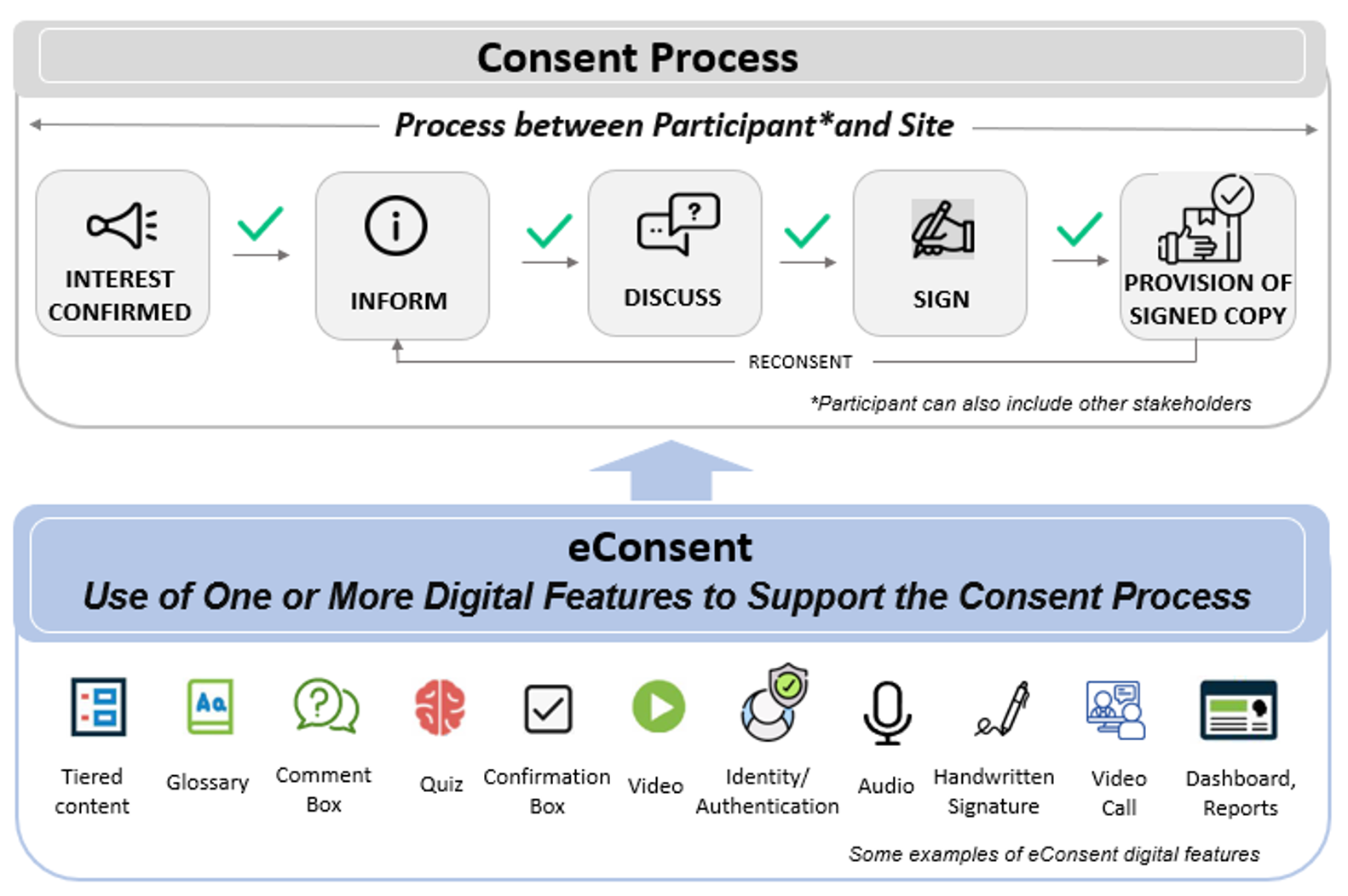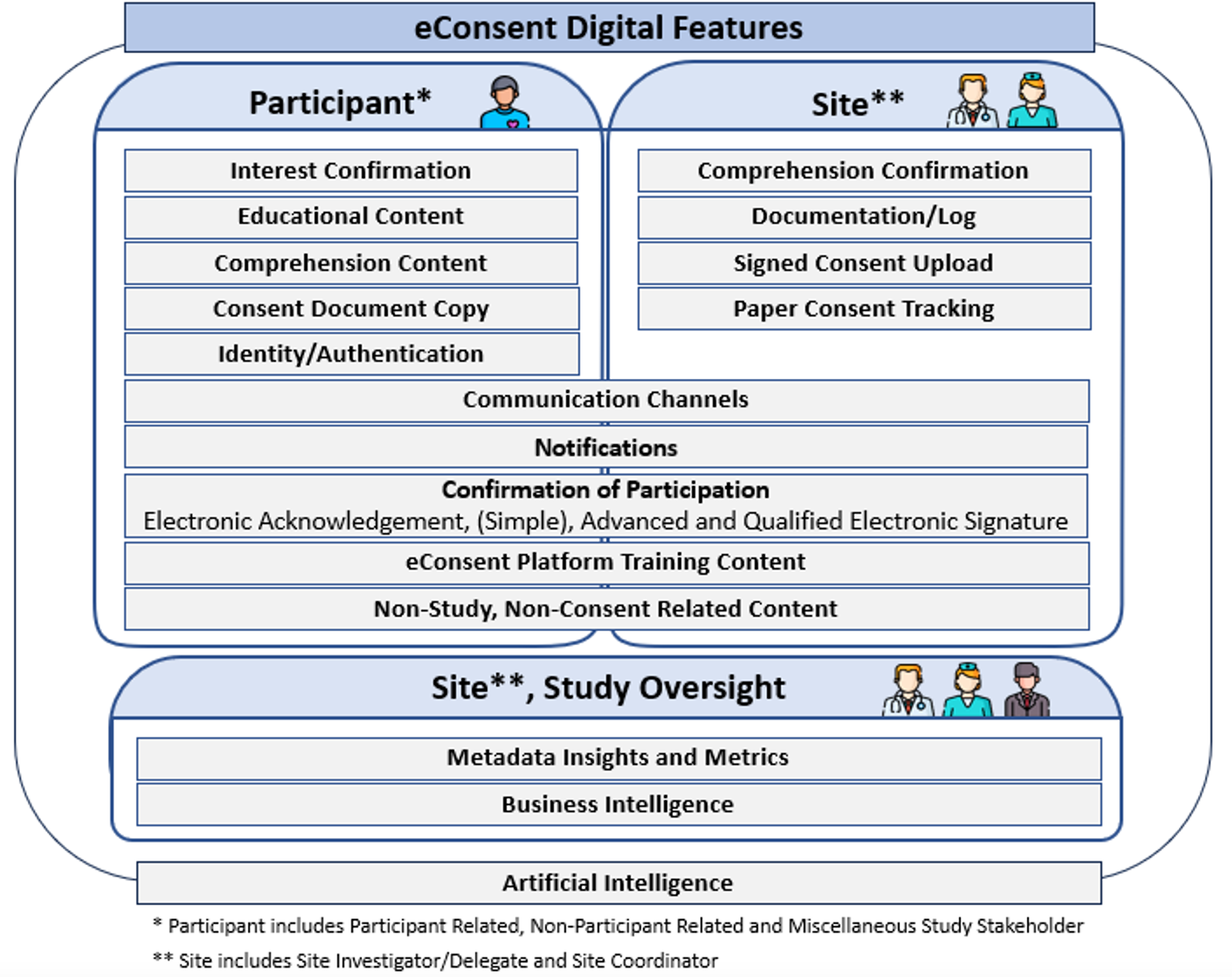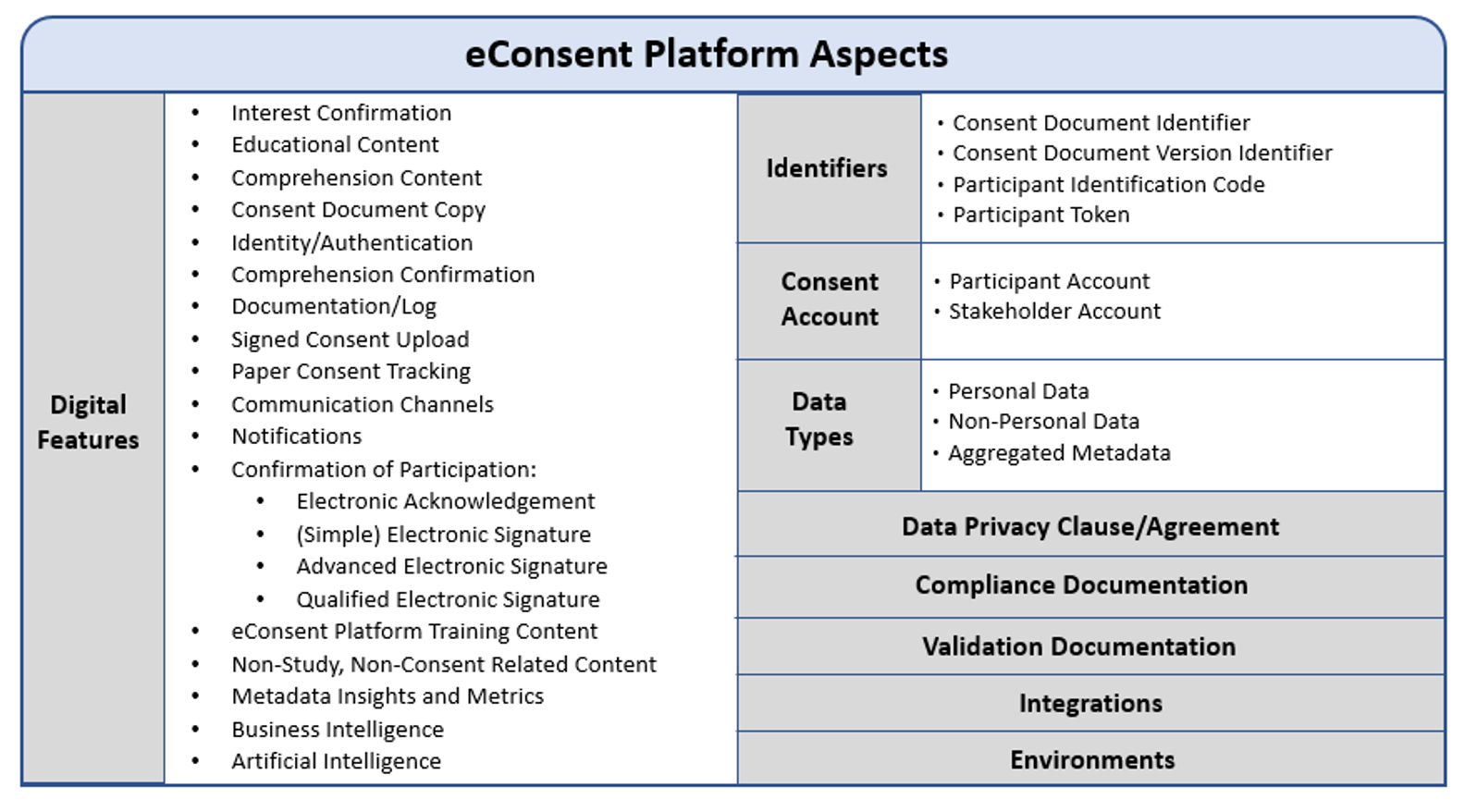eConsent: Why Language Matters
Fostering common eConsent terminologies enriches communication and understanding across all stakeholders.

Ask a group of industry professionals to describe ‘eConsent’ and you will get a variety of answers. Some of these answers may reflect a limited understanding of eConsent, and some may even propagate misconceptions around the use of eConsent. A recent poll at the DIA 2023 Global Annual Meeting’s eConsent session1 asked attendees about the use of eSignature: 78% responded that eConsent requires an electronic signature, propagating a common misconception around the varied uses of eConsent.
Widespread misunderstandings result in conflicting messages around the acceptance of eConsent, lack of clarity regarding study documents required for Health Authority and Ethics Committee submissions,2 and incomplete insights about the benefits and challenges posed to stakeholders.
Having harmonized terminologies to describe the platform and operational aspects of eConsent is critical to eliminate misconceptions and to enable transparency and a common understanding between all stakeholders. This was precisely the focus and intent when developing the Glossary of eConsent terms, one of the deliverables of the multi-stakeholder, non-profit European Forum for Good Clinical Practice (EFGCP) eConsent Initiative,3 Where applicable, references to existing terminologies are incorporated in the glossary.4-15
In addition, the glossary can also serve as a general knowledge base of key aspects to consider for sponsors and vendors when deploying eConsent. Of note, even within our group of industry experts from over 50 different organizations, we had several “eureka” moments as we learned from each other’s insights.
In this article, we will highlight some key considerations and discussions on eConsent terminologies.
What is eConsent?
“eConsent” is an overarching term and there are multiple different eConsent models—there is no one-size-fits-all. The main point of commonality between all models is “the use of one or more digital features to support the consent process,” reflecting the essence and definition of eConsent.
Of note, eConsent only augments the overall consent process, it does not change any of the traditional paper consent process steps—confirming interest, informing, discussing, signing, and providing a signed copy—as represented in Figure 1 along with some examples of eConsent digital features.
Figure 1. eConsent Definition and Some Examples of eConsent Digital Features.

Harmonizing eConsent platform and operational aspects terminologies
Since there is no one-size-fits-all eConsent model, it is important to understand and describe the underlying platform and operational aspects underpinning a variety of eConsent models, in an easily understandable and harmonized manner.
The Glossary of eConsent Terms encompasses two sections:
- eConsent Platform Aspects terminologies cover key aspects related to the eConsent platform, data, and technology. eConsent digital features, as an example, are covered in this section.
- eConsent Operational Aspects terminologies cover key aspects related to the operational management of eConsent. These aspects are typically also applicable to the traditional paper consent process and examples include terms related to stakeholders, locations, or device deployment.
It is important to note that there is often an interplay between the platform and operational aspects of eConsent, so none of the aspects described in the glossary should be looked at in isolation.
Digital features as the foundation of eConsent
The approach used for harmonizing the terminologies of eConsent digital features—one of the fundamental eConsent platform aspects—was to cluster individual examples based on their characteristics and commonalities. Figure 2 illustrates the different eConsent digital features in line with their stakeholder applicability.
Figure 2. Overview of eConsent Digital Features and Stakeholders’ Applicability.

Several interesting discussions took place regarding the core characteristics of eConsent digital features and how to make broadly used concepts such as “engaging” or “interactive” more concrete. This resulted in the terms “Educational Content” and “Comprehension Content” to differentiate between digital features that a participant cannot interact with (beyond consuming the content) versus those that might require an interaction by the participant. Examples include text, video, or audio for “Educational Content”, versus a quiz, content flags, or comment boxes for “Comprehension Content.”
Depending on the digital feature used, other actions might be triggered. To illustrate, when deploying digital features relating to “Comprehension Content”, the site should be able to close the loop on any questions, concerns, or knowledge gaps raised by the participant. Such site digital features were clustered under the term “Comprehension Confirmation” and examples include site confirmation checkboxes or site comment fields.
Another key discussion encompassed—as one would expect—“eSignatures.” In the glossary, we used the European eIDAS terminologies7—Simple, Advanced and Qualified Electronic Signatures—under the “Confirmation of Participation” category and also added “Electronic Acknowledgement.”
It is crucial to highlight that different regulations and categorizations of electronic signatures apply across regions, resulting in many disconnects when using a generic term such as “eSignature.” For example, “a handwritten signature drawn by finger or stylus on an electronic device” is considered an eSignature according to European eIDAS regulations,7 but NOT according to FDA regulations.8 So, a crucial and fundamental call out to industry is to always describe the “Confirmation of Participation” digital feature, and not use the term eSignature. For example, a description as “a handwritten signature drawn by finger or stylus on an electronic device” is clear and understandable for all stakeholders and allows a correct assessment independent of how it is categorized by local or regional regulations. Some examples of descriptions for each of the eIDAS eSignature categories7 are included in the glossary.
Another topic with a number of disconnects within our team was on paper consent activities, especially those that can become an eConsent digital feature. Two eConsent digital feature terms—“Signed Consent Upload” and “Paper Consent Tracking”—were added to ensure these digital features are aptly described and considered when evaluating eConsent deployment.
Other eConsent platform aspects of interest
Apart from eConsent digital features, several other terms related to the platform aspects of eConsent were defined and are illustrated in Figure 3.
Figure 3. Overview of Key eConsent Platform Aspects.

One example to highlight is the delineation between, “Participant Account” and “Stakeholder Account,” two terms described under the category “Consent Accounts.” Besides the participant, other stakeholders might be directly or indirectly involved in the consent process, and it is fundamental to evaluate and consider the needs of all these stakeholders. For example, do they require separate stakeholder accounts, uniquely linked to the participant, to individually interact, document their actions and/or provide their agreement during the consent process.
Also, on the eConsent platform aspect of “Identifiers”—either related to the consent document or the participant—it was interesting to see how many different terminologies exist, and/or the same terminologies but with a different understanding. We kept the terms as simple and clear as possible, and also added the term “Participant Token” to help with the understanding and harmonization of this term often mentioned during eConsent discussions.
Operational aspects as key actors of eConsent
In addition to the platform aspects of eConsent, the operational context plays an equally important role in defining the eConsent model that best fits the needs of a particular study and involved stakeholders.
Figure 4 illustrates the key operational aspects of eConsent as described within the Glossary of eConsent Terms. Notably, these operational aspects also often encompass the fundamental requirements of the traditional paper consent process.
Figure 4. Key Operational Aspects of eConsent.

Similarly, as with the eConsent platform aspects, many of the eConsent operational aspects led to interesting discussions between our team of eConsent experts. For example, some companies used “in person” to describe a video call, while others used it to describe a physical meeting. Likewise, “remote” was often considered as requiring many digital features to support (nearly) all consent process steps, which is an incorrect interpretation. Remote consent may only utilize “one” digital feature (e.g., a video call) for the discussion between participant and the site investigator/delegate, while all other consent process steps can be accomplished using paper forms via traditional processes. Or for some non-interventional studies, remote consent might even be conducted without the involvement of any digital feature and hence would not fit the definition of eConsent.
To ensure harmonized understanding, we defined “In the Same Location,” “Not in the Same Location” and “Mixed Location” as terminologies under the “Participant/Site Location” category. “Mixed Location” refers to a hybrid model where some consent process steps between the site investigator/delegate and participant are completed in the same location while others are not. For example, sharing of the consent information is done via email (“Not in the Same Location”) while the discussion is done at the investigator site (“In the Same Location”).
Another key area of our consent experts’ discussion involved “Consent Categorization” with multiple opinions around the concepts of “Main Consent Document”, “Optional Consent Document” and “Assent Document.” In fact, “Assent” was recently introduced in ICH GCP E6(R3)4 as a defined glossary term.
Similarly, numerous discussions took place to describe the different consent stages as part of the “Consent Workflow” category, resulting in the addition of the term “Dynamic Consent” to describe a more dynamic way to keep participants updated about what is ongoing (e.g., with their bio-samples), while also regularly reconfirming their agreement to participate.15
Eliminating misunderstanding: A fundamental step to enable broader eConsent adoption
To recap, it is vital to remember that there is no “one-size-fits-all” eConsent model. Every study should carefully consider the various eConsent platform and operational aspects and define the best eConsent model in line with study and stakeholder needs.
Standardizing the nomenclature and terminologies used to describe various aspects of eConsent to enable a common understanding and facilitate adoption of eConsent was the foundational goal when developing the Glossary of eConsent Terms. In addition, the glossary can also be used as a comprehensive reference guide for sponsors and vendors when considering and evaluating which platform and operational aspects of eConsent are most suitable for their needs.
Of note, not every stakeholder needs to be overloaded with eConsent platform terminologies. For example, a complex or technical term such as "Participant Token" may not need to be described in detail to a participant in an informed consent document. However, the consent documents should focus instead on the potential risks and benefits of a "Participant Token," including why it is being utilized in the study.
It is important to recognize that this Glossary of eConsent Terms is a dynamic, evolving tool rather than a final resource. Digital feature terms such as “Artificial Intelligence”5—which can impact several other aspects of eConsent – are just at the initial stages of being explored and might more fully emerge over time, and/or other novel technologies might be introduced that could also transform the eConsent landscape.
Within the European Forum GCP eConsent Initiative, we have started to combine the various platform and operational aspects defined in the glossary with other workstream activities. For example, which aspects might have the most impact on the benefits and challenges of different stakeholders. This can help industry to better define the eConsent model that would work best within the context of a given study and involved stakeholders, while reducing incorrect assumptions.
Ultimately, our goal is to bring eConsent to the forefront of modern clinical research practice and enable anyone, anywhere, anytime to make an informed decision about whether to participate in a clinical trial. We hope this glossary of harmonizing terminologies is a first, critical step in that journey.
Supplemental information
The Glossary of eConsent Terms developed by the EFGCP eConsent Initiative can be accessed via https://efgcp.eu/econsent-folder?access=Why-Language-Matters
Acknowledgements
This significant work would not have been achievable without the invaluable support, in-depth discussions, and active engagement of the EFGCP eConsent Library Workstream team with special thanks to Jennifer Lentz (Lilly), Jo Dehwurst (ICON), Mateusz Karasiewicz (ICON), Manuela Ghielli (Galapagos), Mia Allen (Cambridge Cognition), Jennifer Ribeiro (BMS), Tina Caruana (Medrio), Vinita Navadgi (IQVIA), Sam Thomas (ClinOne) and Jaime Fons-Martinez (Fisabio).
About the authors
Hilde Vanaken (TCS) spearheads the EFGCP eConsent initiative consisting of 6 workstreams. Rebecca Zeising (PharmaTrail), Bethany Pryski (Pfizer) and Liz Goodman (Clinical Ink) are co-leaders of the EFGCP eConsent Library Workstream which developed the Glossary of eConsent Terms.
References
- “Industry and Regulators’ Experience with the Implementation and Use of Remote and Electronic Consent” session at the DIA 2023 Global Annual Meeting on 28 June 2023. https://www.linkedin.com/posts/hilde-vanaken-25081a6_dia-2023-what-is-the-european-forum-gcp-activity-7089326604492972032--WQD?utm_source=share&utm_medium=member_desktop
- Vanaken, H. et al. Navigating eConsent Submissions: Who, Where, What and Why? Applied Clinical Trials, 10 November 2023. https://www.appliedclinicaltrialsonline.com/view/navigating-econsent-submissions-who-what-where-and-why-
- Vanaken, H. eConsent is Not What You Think. Applied Clinical Trials, 12 May 2023. https://www.appliedclinicaltrialsonline.com/view/econsent-is-not-what-you-think
- ICH Harmonized Guideline, Good Clinical Practice (GCP) E6(R3), Draft version 19 May 2023. https://database.ich.org/sites/default/files/ICH_E6%28R3%29_DraftGuideline_2023_0519.pdf
- EMA Guideline on computerized systems and electronic data in clinical trials. March 2023. https://www.ema.europa.eu/en/documents/regulatory-procedural-guideline/guideline-computerised-systems-electronic-data-clinical-trials_en.pdf
- HMA, EC & EMA, Recommendation Paper on Decentralized Elements in Clinical Trials, Version 01, 13 December 2022. https://health.ec.europa.eu/latest-updates/recommendation-paper-decentralised-elements-clinical-trials-2022-12-14_en
- Reflection Paper on the Use of Artificial Intelligence (AI) in the Medicinal Product Lifecycle, Draft version 13 July 2023. https://www.ema.europa.eu/en/news/reflection-paper-use-artificial-intelligence-lifecycle-medicines
- General Data Protection Regulations, April 2016 https://eur-lex.europa.eu/legal-content/EN/TXT/?uri=CELEX%3A02016R0679-20160504&qid=1532348683434
- EU Regulation on Electronic Identification and Trust Services for Electronic Transactions in the Internal Market (eIDAS), July 2014. https://eur-lex.europa.eu/legal-content/EN/TXT/?uri=uriserv%3AOJ.L_.2014.257.01.0073.01.ENG
- FDA Draft guidance on Electronic Systems, Electronic Records, and Electronic Signatures in Clinical Investigations. Questions and answers. March 2023. https://www.fda.gov/regulatory-information/search-fda-guidance-documents/electronic-systems-electronic-records-and-electronic-signatures-clinical-investigations-questions
- FDA, Informed Consent: Guidance for IRBs, Clinical Investigators, and Sponsors, August 2023. https://www.fda.gov/media/88915/download
- FDA & OHRP, Use of Electronic Informed Consent, Questions and Answers: Guidance for Institutional Review Boards, Investigators and Sponsors, December 2016. https://www.fda.gov/media/116850/download
- Transcelerate eConsent Guidance. https://www.transceleratebiopharmainc.com/wp-content/uploads/2021/02/eConsent-Implementation-Guidance_February-2021.pdf
- Vanaken, H. and Masand, S. Awareness and collaboration across stakeholder groups important for eConsent achieving value-driven adoption. Therapeutic Innovative Regulatory Science, 2019. https://journals.sagepub.com/doi/full/10.1177/2168479019861924
- Ten years of dynamic consent in the CHRIS study: Informed consent as a dynamic process. https://pubmed.ncbi.nlm.nih.gov/36064788/
Newsletter
Stay current in clinical research with Applied Clinical Trials, providing expert insights, regulatory updates, and practical strategies for successful clinical trial design and execution.
Effect of AI/ML, Real World Evidence and Master Protocols on Trial Success
July 7th 2025How the application of artificial intelligence, broader use of real-world evidence, decentralized clinical trials, master protocols, and risk-based quality monitoring, together with strong ethical oversight and increased collaboration, are contributing to better healthcare delivery and strengthening the role of clinical research in driving global health progress.
Improving Relationships and Diversifying the Site Selection Process
April 17th 2025In this episode of the Applied Clinical Trials Podcast, Liz Beatty, co-founder and chief strategy officer, Inato, discusses a number of topics around site engagement including community-based sites, the role of technology in improving site/sponsor relationships, how increased operational costs are impacting the industry, and more.
Reaching Diverse Patient Populations With Personalized Treatment Methods
January 20th 2025Daejin Abidoye, head of solid tumors, oncology development, AbbVie, discusses a number of topics around diversity in clinical research including industry’s greatest challenges in reaching diverse patient populations, personalized treatment methods, recruitment strategies, and more.
Funding Cuts Threaten Diversity in Clinical Research
June 27th 2025In this video interview, Kyle McAllister, co-founder, CEO, Trially, discusses how recent federal funding cuts are likely to undermine research focused on underrepresented populations, and why long-term investment in community-based studies is essential to closing persistent health equity gaps.